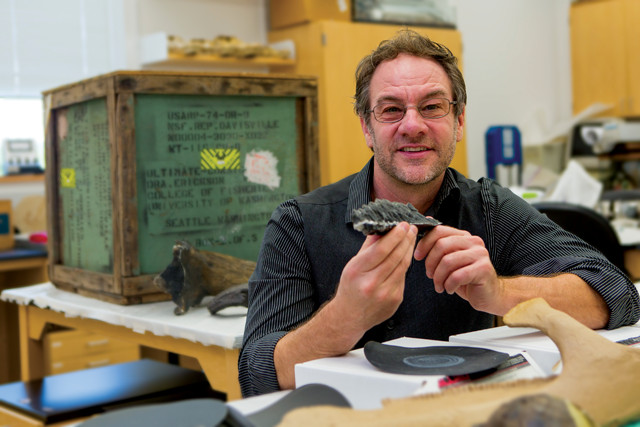
by Bethany Augliere Tuesday, April 18, 2017

Gregory Erickson examined teeth in dinosaur embryos to assess their incubation times. Credit: Bill Lax/FSU Photography Services.
Paleontologists have long thought that the eggs of dinosaurs — like those of their living bird relatives — probably hatched after short incubation times, up to a few weeks at most. But surprising results from a new study suggest that nonavian dinosaurs spent anywhere from three to six months inside an egg, incubation times similar to reptiles like crocodiles and alligators.
“We know a lot about dinosaur growth, population biology and feeding biomechanics, but we haven’t been able to make much headway with regard to their embryology,” says Gregory Erickson, a paleontologist at Florida State University and lead author of the study, published in Proceedings of the National Academy of Sciences. That’s because fossil dinosaur embryos “are the rarest of rare dinosaur specimens,” he says.
Previously, scientists have quantified dinosaur incubation times by assuming dinosaur embryos developed rapidly, like bird embryos, and by comparing dinosaur egg size or adult body size to modern birds. In the new work, however, Erickson and his team looked at tooth development in fossil embryos from two Late Cretaceous plant-eating ornithischians, Protoceratops and Hypacrosaurus, whose eggs range from some of the smallest to some of the largest known. The Protoceratops embryos came from a nest of 12 potato-shaped eggs, each weighing about 200 grams, found in Mongolia’s Gobi Desert. The Hypacrosaurus embyros came from round, nearly 4-kilogram eggs found in southern Alberta, Canada.
As the hard outer enamel forms during embryonic tooth formation in animals, liquid dentin fills the inside of the tooth, mineralizing each night. The process creates daily growth lines called von Ebner lines, which can be counted like tree rings. Eventually, dentine fills in the tooth completely and von Ebner lines stop forming.
In alligators, as well as humans and other mammals, scientists have counted von Ebner lines to determine tooth-formation times and corresponding incubation times. Erickson and his colleagues wanted to see if the same technique could be used in baby dinosaurs, but no one had ever looked to see if the lines were present in dinosaur teeth — they were.
“I’m surprised nobody had done it before,” says Steve Brusatte, a paleontologist at the University of Edinburgh in Scotland who was not involved in the new study. The novel application of this technique “speaks to how interesting, how important this study is,” he says.
Using CT scans of the developing embryonic Protoceratops and Hypacrosaurus dentitions and the width of the von Ebner lines, the researchers found that the dinosaurs had incubation times of 83 and 171 days, respectively, each more than twice as long as expected if their incubation times were similar to modern birds and given the sizes of the eggs. “This shows that the rapid incubation of modern birds wasn’t something that they inherited from their early dinosaur ancestors, but instead that it must have evolved much later, probably sometime around the origin of flight, roughly 150 million years ago, or maybe even after flight evolved,” Brusatte says.
The study also places valuable constraints on scientists’ understanding of dinosaur ecology, says David Varricchio, a paleontologist at Montana State University who was not involved in the study. “The results imply that dinosaurs would be potentially devoting a big chunk of their year to reproduction,” Varricchio says, if there is parental care of the young, which previous research has indicated.
Paleontologists have previously speculated that dinosaurs hatched in Alberta or Montana would subsequently journey with their parents roughly 2,800 kilometers to the Arctic — relatively warm and lush at the time — to take advantage of the summer foliage. “But with a six-month incubation period, that leaves a small window to get these little guys trekking that far,” Erickson says. “I think it’s very unlikely that happened.”
Long incubation times may have also contributed to dinosaurs’ downfall during the end-Cretaceous mass extinction, a time of dramatic climate change and diminished resources. Dinosaurs were endothermic, meaning they required a lot of energy to keep their body temperatures stable. They also took a long time to reach sexual maturity. Combined with long incubation times, these traits could have led to dinosaurs being outcompeted by reptiles, birds, amphibians and small mammals in filling ecological niches, Erickson says.
He and his colleagues hope to continue examining dinosaur embryos, particularly from theropods, a group that includes species like Velociraptor, and which gave rise to modern birds. Figuring out if theropods had long incubations like other dinosaurs, or if they were more bird-like, might help scientists determine when fast incubation evolved, Brusatte says. “If it turns out that modern birds are the only ones that incubate very quickly, it could be that this gave them a better chance for surviving” through the end-Cretaceous extinction.
© 2008-2021. All rights reserved. Any copying, redistribution or retransmission of any of the contents of this service without the expressed written permission of the American Geosciences Institute is expressly prohibited. Click here for all copyright requests.